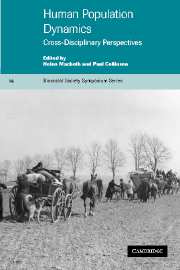Book contents
- Frontmatter
- Contents
- List of contributors
- Foreword by G.A. Harrison
- Preface
- 1 Introduction: the framework of studying human population dynamics
- 2 Demographic perspectives on human population dynamics
- 3 The growing concentration of world population from 1950 to 2050
- 4 Population, community and society in peasant societies
- 5 From genetic variation to population dynamics: insights into the biological understanding of humans
- 6 Social institutions and demographic regimes in non-industrial societies: a comparative approach
- 7 The dynamics of child survival
- 8 Genetic structure of south Indian caste populations: a confluence of biology and culture
- 9 Fertility, mortality and migration transitions in association with socioeconomic modernisation among highland minority populations in Southeast Asia
- 10 Ecology, homeostasis and survival in human population dynamics
- Glossary
- Index
- References
4 - Population, community and society in peasant societies
Published online by Cambridge University Press: 11 August 2009
- Frontmatter
- Contents
- List of contributors
- Foreword by G.A. Harrison
- Preface
- 1 Introduction: the framework of studying human population dynamics
- 2 Demographic perspectives on human population dynamics
- 3 The growing concentration of world population from 1950 to 2050
- 4 Population, community and society in peasant societies
- 5 From genetic variation to population dynamics: insights into the biological understanding of humans
- 6 Social institutions and demographic regimes in non-industrial societies: a comparative approach
- 7 The dynamics of child survival
- 8 Genetic structure of south Indian caste populations: a confluence of biology and culture
- 9 Fertility, mortality and migration transitions in association with socioeconomic modernisation among highland minority populations in Southeast Asia
- 10 Ecology, homeostasis and survival in human population dynamics
- Glossary
- Index
- References
Summary
Definitions
In contrast to the two very similar definitions of population provided in the two previous chapters by a demographer and by a geographer, in evolutionary biology a population is viewed as a construct involving a set of organisms that share a genetic ancestry and interbreed. A community, on the other hand, is a set of people with common interests, values and distinctive patterns of social interaction, often occupying a single geographical area. Society consists of all the people encompassed by a total, relatively self-sufficient network of institutions within which their social interactions take place. Peasant communities have been described as ‘part societies’ (Redfield 1960). A peasant is a cultivator whose productive activities are primarily directed toward his/her household's subsistence needs, but who is under some degree of economic and political obligation to powerful outsiders and/or carries out subsidiary production for a market operating in the wider society. Peasants also interact on a daily basis with other members of their local community.
Through an examination of the interaction between population, community and society in peasant communities, this chapter will illustrate how studies of peasants can throw light on the relationship between the sociocultural environment and the dynamics of human population biology affecting individuals' survival and reproductive success, i.e. mortality and fertility. The chapter begins by summarising a long-running debate concerning the relative importance of the individual and the ecological or social system to which that individual belongs.
- Type
- Chapter
- Information
- Human Population DynamicsCross-Disciplinary Perspectives, pp. 65 - 82Publisher: Cambridge University PressPrint publication year: 2002
References
- 1
- Cited by



